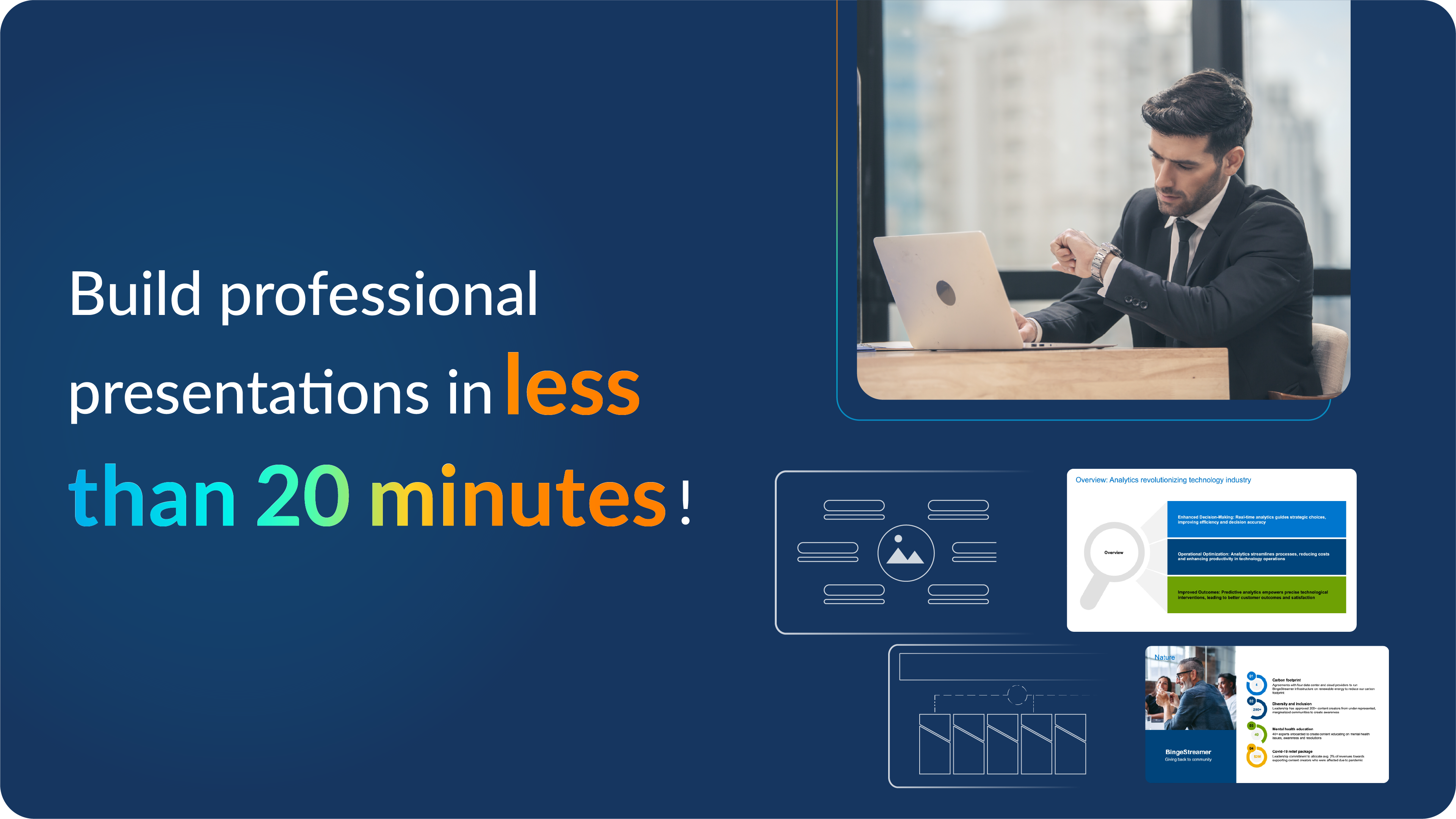Request for proposal (RFP) presentation: A comprehensive guide

Hey there, fellow presentation enthusiasts!
Are you ready to dive into the world of Request for Proposal (RFP) presentations?
Well, you're in for a treat. In today's digital age, creating a winning RFP presentation is crucial for businesses aiming to secure contracts, land new projects, and ultimately, thrive in their respective industries.
So, grab your digital pens and pointers, because we're about to embark on a journey through the ins and outs of RFP presentations.
What is a request for proposal (RFP) presentation?
Before we get too deep into the nitty-gritty of RFP presentations, let's ensure we're all on the same page. An RFP presentation is a key component of the proposal process. It's your opportunity to visually communicate your company's qualifications, expertise, and the proposed solution to potential clients or stakeholders. In essence, it's your digital pitch, aimed at convincing decision-makers that you're the best fit for the job.
Different types of RFP presentation
As you embark on your journey to master the art of Request for Proposal (RFP) presentations, it's crucial to understand the diverse types of presentations you might encounter. RFP presentations come in various forms, each designed to suit different scenarios and preferences. Let's dive into the world of RFP presentation formats:
Pre-planned vs. ad hoc RFP oral presentations
Pre-planned presentations: These are the most common type of RFP presentations. Typically, they are scheduled well in advance, allowing you ample time to prepare, rehearse, and fine-tune your material. Pre-planned presentations follow a structured format and are ideal for showcasing your expertise in a methodical manner.
Ad hoc presentations: While less common, ad hoc presentations may be requested when clients have specific questions about your proposal or when there are multiple highly competitive finalists. These presentations are typically shorter, less formal, and delivered on the spot. Ad hoc presentations demand quick thinking and the ability to adapt to unexpected inquiries.
In-person vs. virtual RFP oral presentations
In-person presentations: Traditional in-person RFP presentations require you to travel to the client's location, providing a face-to-face interaction. These presentations are often favored for their personal touch and the opportunity to establish a strong rapport with the audience.
Virtual presentations: In today's digital age, virtual RFP presentations have gained prominence, especially in the wake of the COVID-19 pandemic. They are delivered online using platforms such as Zoom or Microsoft Teams. Virtual presentations offer the flexibility to connect with clients remotely, saving time and resources.
In addition to these primary RFP presentation types, you may also come across the following formats:
Demo Presentations: Are a powerful tool for showcasing your product or service in action. They provide a visual and interactive demonstration, allowing the client to gain a deeper understanding of how your solution can precisely meet their needs. This type of presentation can be especially effective in industries where visual representation is key.
Q&A Sessions: Are typically held at the conclusion of an RFP presentation. They provide clients with the opportunity to ask questions about your proposal, seek clarifications, and address any concerns they may have. This is an invaluable chance to demonstrate your expertise and show that you have a thorough understanding of your solution.
No matter which type of RFP presentation you are tasked with, the key to success lies in preparation and professionalism. Take the time to thoroughly understand the client's requirements, tailor your presentation to meet their specific needs, and approach each presentation with confidence and expertise. Your ability to adapt to different presentation styles and connect with your audience will be a significant factor in winning bids and securing valuable contracts.
What should a request for proposal (RFP) presentation include?
Now that we know what an RFP presentation is, what exactly should it include to leave a lasting impression? Here's a breakdown:
- Introduction: Start by introducing your company. Who are you, and why are you a top-notch choice for this project?
- Company background: Provide background information about your company, its history, mission, and values.
- Team members: Highlight the key team members who will be involved in the project.
- Qualifications: Showcase your qualifications, including relevant certifications and previous successful projects.
- Presentation slides: Discuss the structure of your presentation. What are you going to cover, and how will it be organized?
- RFP process: Explain the process you'll follow to respond to the RFP, including deadlines and milestones.
- Bid details: Specify the bid details, such as pricing and payment terms.
- Problem-solution statement: Clearly outline the problem your proposal addresses and how your solution solves it.
- Evaluation process: Describe how your proposal will be evaluated and the criteria that will be used.
- Conclusion: Sum up your proposal and express your enthusiasm for the opportunity.
How to structure an effective request for proposal (RFP) presentation
Structure is crucial for creating an impactful RFP presentation. Here's a suggested structure:
1. Introduction: Grab the audience's attention. Introduce your company and its mission. State the purpose of your presentation.
2. Company background: Provide an overview of your company's history and values. Highlight your company's strengths.
3. Team members: Introduce the key team members involved in the project. Emphasize their expertise and qualifications.
4. Qualifications: Showcase your company's qualifications and certifications. Mention past successful projects and clients.
5. Presentation slides: Explain the structure of your presentation. Detail what each slide will cover.
6. Rfp templates: Stress the importance of professional presentation design, visually appealing templates. Discuss how they enhance your presentation's impact.
7. RFP process: Describe the process you'll follow to respond to the RFP. Include deadlines and key milestones.
8. Bid details: Specify pricing, payment terms, and any other financial details.
9. Problem-solution statement: Clearly define the problem and how your solution addresses it. Provide evidence of your solution's effectiveness.
10. Evaluation process: Explain how your proposal will be evaluated. Detail the criteria and metrics that will be used.
11. Conclusion: Summarize your proposal's key points. Express your enthusiasm for the opportunity.
Do's and don'ts on a request for proposal (RFP) presentation
So, what should you do and what should you avoid when creating your RFPs presentation? Here's a handy list of do's and don'ts:
Do's:
- Do research: Thoroughly understand the client's needs and expectations.
- Do be concise: Keep your presentation focused and to the point.
- Do use visuals: Incorporate compelling visuals to enhance your message.
- Do customize: Tailor your presentation to the specific RFP and client.
- Do practice: Rehearse your presentation to ensure a smooth delivery.
Don'ts:
- Don't overload: Avoid overwhelming your audience with excessive information.
- Don't ignore design: Neglecting the visual aspect can detract from your message.
- Don't skip proofreading: Typos and errors can make your proposal appear unprofessional.
- Don't miss deadlines: Always meet submission deadlines.
- Don't overpromise: Be honest and realistic about what your company can deliver.
Summarizing Key Takeaways
- Understanding RFP presentations: RFP presentations are a crucial part of the proposal process, serving as a digital pitch to communicate a company's qualifications and proposed solutions to potential clients or stakeholders.
- Types of RFP presentations: There are various types of RFP presentations, including pre-planned vs. ad hoc and in-person vs. virtual presentations, each suited to different situations and preferences.
- Additional presentation formats: Other formats include demo presentations and Q&A sessions, which offer opportunities to showcase products or services and address client inquiries.
- Components of an RFP presentation: A comprehensive RFP presentation should include an introduction, company background, team members, qualifications, presentation slides, details of the RFP process, bid specifics, problem-solution statement, evaluation process, and a conclusion.
- Effective presentation structure: A suggested structure for RFP presentations includes an introduction, company background, team members, qualifications, presentation slides, RFP process, bid details, problem-solution statement, evaluation process, and a conclusion.
- Do's and don'ts: Follow best practices, such as thorough research, conciseness, visual elements, customization, and practice. Avoid overloading, neglecting design, missing deadlines, and overpromising in your RFP presentation.
FAQ's
1. What is the importance of a request for proposal (RFP) presentation in the bidding process?
A well-crafted RFP presentation is crucial to winning the bid. It allows you to showcase your company's background, expertise, and services in a persuasive manner, potentially attracting bidders to fund the project. An impactful RFP presentation can make the difference between success and failure.
2. How can I create an effective RFP presentation using powerpoint or google slides?
To create an impactful RFP presentation, you can utilize customizable content-ready RFP powerpoint templates or themes. These templates come with pre-designed slides and visuals that can help you give a clear idea of your company's capabilities and proposal. Whether you choose prezent, powerpoint or google slides, these templates can save you time and effort in creating a winning presentation.
3. What are the essential components of an RFP presentation?
An effective RFP presentation should include components such as the company's background information, a clear problem-solution statement, and the services offered. It should be based on the best practices for RFP presentations to attract the attention of your potential client and meet the specific criteria and metrics outlined in the original RFP.
4. How can I make sure my RFP presentation stands out from the competition?
To stand out in the RFP bidding process, it's a good idea to use professionally designed RFP powerpoint visuals and present an impactful proposal to your client. The presentation slides should look professional and align with the customer's RFP process. Additionally, you should believe in your business and ensure that your RFP presentation reflects your commitment to achieving the desired goal within the project.
5. How should I handle the oral proposal presentation at the end of the RFP process?
The oral proposal presentation, often the RFP finalist presentation, is a critical step. It's essential to use powerpoint or google slides to create a compelling presentation. You may request a sample RFP or RFP powerpoint template to guide you in creating a winning presentation. Make sure to follow the outline provided in the original RFP, including the presentation timeframe and content requirements, to maximize your chances of winning the bid.
Create your request for proposal presentation with prezent
Creating a compelling request for proposal (RFP) presentation is a critical aspect of any research project, and Prezent offers an invaluable tool to streamline this process. With Prezent's AI business presentation software, you can elevate your RFP presentations and achieve full brand compliance effortlessly. This innovative platform combines several elements crucial for an effective RFP presentation.
One of the standout features of Prezent is its brand-approved design capabilities. The platform allows you to manage documents with ease, ensuring that your RFP presentation aligns perfectly with your corporate brand and marketing guidelines. This ensures that every RFP you create is 100% on-brand, approved by your marketing team, and consistently reflects the values and identity of your organization. With Prezent, you can say goodbye to the challenges of creating RFPs that match your brand standards, as this platform simplifies the process, making it efficient and hassle-free.
In addition to the fantastic suite of features, Prezent can also help you save valuable time and resources. It can cut down presentation creation time by 70%, thanks to its extensive library of 35,000+ slides in your company's brand-approved design. You can master structured storytelling with access to over 50 storylines commonly used by business leaders. By instantly sharing and standardizing your RFPs, you can collaborate seamlessly with colleagues, both within and outside your company, all while reducing communication costs by a staggering 60%. Prezent truly empowers research professionals to create personalized RFP presentations that impress, reflect their brand, and streamline the process from start to finish.
So, go ahead and start crafting your RFP presentation masterpiece with the knowledge you've gained here.
Sign up for our free trial or book a demo today!
Happy presenting!













